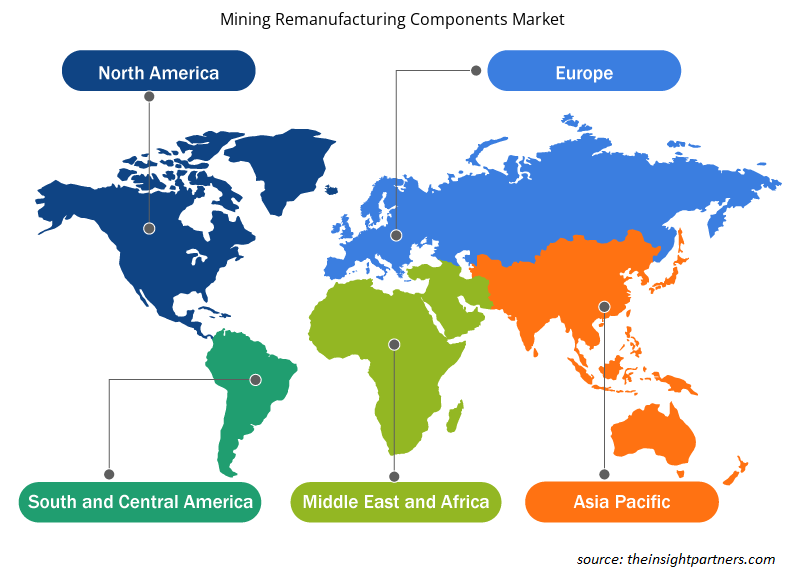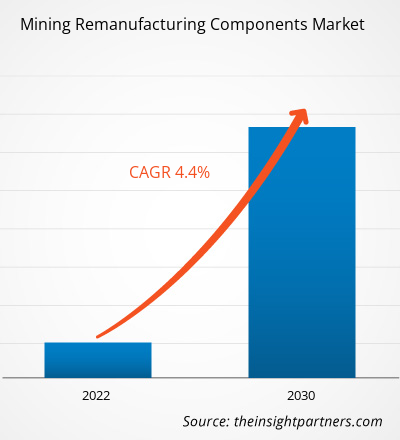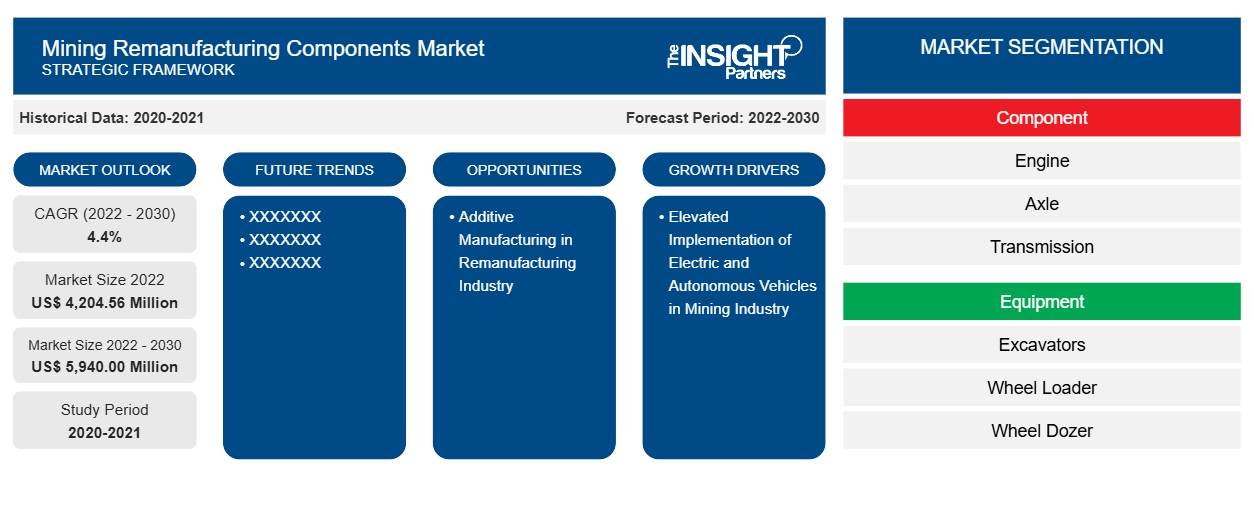Il mercato dei componenti di rigenerazione mineraria è stato valutato a 4.204,56 milioni di dollari USA nel 2022 e si prevede che raggiungerà i 5.940,00 milioni di dollari USA entro il 2030; si prevede che registrerà un CAGR del 4,40% dal 2022 al 2030. È probabile che il crescente sviluppo nel settore minerario rimanga una tendenza chiave nel mercato.remanufacturing components market was valued at US$ 4,204.56 million in 2022 and is projected to reach US$ 5,940.00 million by 2030; it is expected to register a CAGR of 4.40% from 2022 to 2030. The growing development in the mining sector is likely to remain a key trend in the market.
Analisi di mercato dei componenti di rigenerazione minerariaRemanufacturing Components Market Analysis
Si prevede che il crescente sviluppo nel settore minerario e la crescente attenzione alla riduzione della spesa complessiva del ciclo di vita delle attrezzature minerarie alimenteranno la crescita del mercato dei componenti di rigenerazione mineraria a livello globale. Le crescenti scoperte di nuovi siti minerari stanno inoltre rafforzando la domanda di componenti di rigenerazione mineraria in tutto il mondo. I problemi di qualità relativi alle parti dei rigeneratori o ai componenti minerari potrebbero ostacolare la crescita del mercato dei componenti di rigenerazione mineraria. Tuttavia, si prevede che l'implementazione di tecnologie di produzione additiva nel settore minerario guiderà la crescita del mercato nel periodo di previsione.
Panoramica del mercato dei componenti di rigenerazione mineraria
L'attività mineraria è un settore ad alta intensità di capitale. Attrezzature, componenti e dispositivi costosi sono principalmente integrati nel processo complessivo. Le aziende minerarie sono fortemente focalizzate sull'aumento del ciclo di vita dei componenti con processi di manutenzione e rigenerazione periodici per ridurre le possibilità di arresto del sistema e guasti del processo. La crescente attenzione al progresso tecnologico e la crescente enfasi sulla praticità del progetto stanno guidando la domanda di componenti di rigenerazione per l'attività mineraria. Sia i rivenditori che gli specialisti dedicati alla rigenerazione eseguono ispezioni dei componenti principali recuperati per valutare se sono idonei per la rigenerazione. Questa fase elimina la necessità di tempi di attesa che altrimenti sarebbero necessari se le ispezioni fossero eseguite solo presso la struttura di ricezione del nucleo. La fase di progettazione e ingegneria di alto valore del processo di rigenerazione comporta l'uso di tecnologie di produzione additiva avanzate per ripristinare i componenti alle specifiche originali e alle condizioni di nuovo. La sezione dedicata alla rigenerazione sviluppa molte delle tecnologie utilizzate durante questa fase. Il riassemblaggio comprende sia parti rigenerate che nuove, nonché miglioramenti ingegneristici.
Personalizza questo report in base alle tue esigenze
Riceverai la personalizzazione gratuita di qualsiasi report, comprese parti di questo report, o analisi a livello nazionale, pacchetto dati Excel, oltre a usufruire di grandi offerte e sconti per start-up e università
- Scopri le principali tendenze di mercato in questo rapporto.Questo campione GRATUITO includerà analisi di dati che spaziano dalle tendenze di mercato alle stime e alle previsioni.
Driver e opportunità di mercato per i componenti di rigenerazione per l'industria minerariaRemanufacturing Components Market Drivers and Opportunities
La crescita dell'industria mineraria nei paesi sviluppati favorirà il mercato
L'industria mineraria negli Stati Uniti consiste nell'esplorazione, estrazione, arricchimento e lavorazione di minerali solidi naturali presenti sulla terra. Carbone, metalli (come ferro e rame) e minerali industriali sono esempi di minerali estratti. Gli Stati Uniti sono un importante produttore e utilizzatore di minerali e metalli in tutto il mondo. I materiali estratti sono fondamentali per la tecnologia di consumo e industriale e definiscono l'espansione industriale generale degli Stati Uniti. Oltre agli Stati Uniti, la Cina è un altro paese in cui l'industria mineraria è cresciuta a dismisura negli ultimi anni. Pertanto, la crescita continua dell'industria mineraria nelle nazioni sviluppate come gli Stati Uniti e la Cina. Questa crescita nell'attività mineraria ha influenzato direttamente la domanda di attrezzature nel settore, come pale gommate e bulldozer gommati, guidando in ultima analisi la domanda di componenti di rigenerazione mineraria nelle nazioni sviluppate.beneficiation, and processing of naturally existing solid minerals from the earth. Coal, metals (such as iron and copper), and industrial minerals are examples of mined minerals. The US is a major producer and user of minerals and metals worldwide. Mined materials are crucial to consumer and industrial technology and define the general industrial expansion of the US. Apart from the US, China is another country where the mining industry has grown multifold in the past few years. Thus, continuous growth in the mining industry in developed nations such as the US and China. This growth in mining has directly affected the demand for equipment in the industry, such as wheel loaders and wheel dozers, ultimately driving the demand for mining remanufacturing components in developed nations.
Elevata implementazione di veicoli elettrici e autonomi nell'industria mineraria
Il settore minerario si sta concentrando sullo sfruttamento di veicoli minerari "senza conducente" a basse emissioni, che rappresentano una mossa avanzata per la decarbonizzazione. I veicoli elettrici vengono combinati con altre flotte per sfruttare sia le operazioni sotterranee che quelle a cielo aperto, acquistando o rinnovando le flotte di veicoli con motore diesel esistenti. La società Caterpillar ha esposto il suo primo prototipo di veicolo alimentato a batteria presso la sede aziendale di Tuscon, in Arizona, nel 2022. Inoltre, Caterpillar ha lanciato il suo camion minerario EV con una capacità di 240 tonnellate nel 2023. Si prevede che le aziende manifatturiere minerarie aumenteranno l'adozione di camion elettrici per comodità operativa. Si prevede che la domanda aumentata di veicoli elettrici nel settore minerario creerà grandi opportunità per il mercato dei componenti di rigenerazione mineraria durante il periodo di previsione.driverless" mine vehicles which is a advancned move for decarbonization. Electric vehicles are combined with other fleets for leveraging both in the underground and open pit operations by procuring or revamping existing diesel engine vehicle fleets. Caterpillar company had displayed its first battery-powered vehicle prototype at the company's Tuscon, Arizona, in 2022. Furthermore, Caterpillar launched its EV mining truck with a 240-ton capacity in 2023. The mining manufacturing companies are projected to increase the adoption of electric trucks for operational convenience. The augmented demand for electric vehicles in the mining sector is expected to create high opportunities for the mining remanufacturing component market during the forecast period.
Analisi della segmentazione del rapporto di mercato dei componenti di rigenerazione mineraria
I segmenti chiave che hanno contribuito alla derivazione dell'analisi di mercato dei componenti di rigenerazione mineraria sono componenti, attrezzature e industria.
- In base al componente, il mercato dei componenti di rigenerazione mineraria è suddiviso in motore, assale, trasmissione, cilindro idraulico e altri. Il segmento motore ha detenuto la quota maggiore del mercato nel 2022.
- In base all'attrezzatura, il mercato è segmentato in escavatori, pale gommate, dozer gommati, dozer cingolati, autocarri da trasporto e altri. Il segmento dei dozer cingolati ha detenuto la quota maggiore del mercato nel 2022.
- In termini di settore, il mercato è diviso in carbone, metallo e altri. Il segmento del metallo ha detenuto una quota significativa del mercato nel 2022.
Analisi della quota di mercato dei componenti di rigenerazione mineraria per area geografica
L'ambito geografico del rapporto sul mercato dei componenti di rigenerazione per l'industria mineraria è suddiviso principalmente in cinque regioni: Nord America, Asia Pacifico, Europa, Medio Oriente e Africa, e Sud e Centro America.
L'Asia Pacifica è leader del mercato. La Cina è uno dei paesi più importanti nel mercato dei componenti di rigenerazione mineraria nell'Asia Pacifica. I significativi finanziamenti del governo cinese per lo sviluppo del settore minerario e l'attenzione all'innovazione di prodotto creano opportunità per il mercato dei componenti di rigenerazione mineraria. L'industrializzazione e un numero crescente di progetti minerari stanno agendo come un importante motore per il mercato.
Approfondimenti regionali sul mercato dei componenti di rigenerazione mineraria
Le tendenze regionali e i fattori che influenzano il Mining Remanufacturing Components Market durante il periodo di previsione sono stati ampiamente spiegati dagli analisti di Insight Partners. Questa sezione discute anche i segmenti di Mining Remanufacturing Components Market e la geografia in Nord America, Europa, Asia Pacifico, Medio Oriente e Africa e Sud e Centro America.

- Ottieni i dati specifici regionali per il mercato dei componenti di rigenerazione mineraria
Ambito del rapporto di mercato sui componenti di rigenerazione mineraria
| Attributo del report | Dettagli |
|---|---|
| Dimensioni del mercato nel 2022 | 4.204,56 milioni di dollari USA |
| Dimensioni del mercato entro il 2030 | 5.940,00 milioni di dollari USA |
| CAGR globale (2022-2030) | 4,4% |
| Dati storici | 2020-2021 |
| Periodo di previsione | 2022-2030 |
| Segmenti coperti | Per componente
|
| Regioni e Paesi coperti | America del Nord
|
| Leader di mercato e profili aziendali chiave |
|
Densità degli attori del mercato: comprendere il suo impatto sulle dinamiche aziendali
Il mercato dei componenti di rigenerazione mineraria sta crescendo rapidamente, spinto dalla crescente domanda degli utenti finali dovuta a fattori quali l'evoluzione delle preferenze dei consumatori, i progressi tecnologici e una maggiore consapevolezza dei vantaggi del prodotto. Con l'aumento della domanda, le aziende stanno ampliando le loro offerte, innovando per soddisfare le esigenze dei consumatori e capitalizzando sulle tendenze emergenti, il che alimenta ulteriormente la crescita del mercato.
La densità degli operatori di mercato si riferisce alla distribuzione di aziende o società che operano in un particolare mercato o settore. Indica quanti concorrenti (operatori di mercato) sono presenti in un dato spazio di mercato in relazione alle sue dimensioni o al valore di mercato totale.
Le principali aziende che operano nel mercato dei componenti di rigenerazione per l'industria mineraria sono:
- AB Volvo
- Atlante Copco
- Caterpillar Inc.
- Epiroc AB
- Macchine edili Hitachi
- Azienda JC Komatsu Ltd.
Disclaimer : le aziende elencate sopra non sono classificate secondo un ordine particolare.

- Ottieni una panoramica dei principali attori del mercato dei componenti di rigenerazione mineraria
Notizie e sviluppi recenti sul mercato dei componenti di rigenerazione mineraria
Il mercato dei componenti di rigenerazione mineraria viene valutato raccogliendo dati qualitativi e quantitativi dopo la ricerca primaria e secondaria, che include importanti pubblicazioni aziendali, dati di associazioni e database. Di seguito sono elencati alcuni degli sviluppi nel mercato dei componenti di rigenerazione mineraria:
- SRC Holdings ha completato il suo nuovo magazzino, occupato da SRC Logistics (SRCL), su North Mulroy Road a Springfield. La struttura di 413.000 piedi quadrati, completata dopo 13 mesi di costruzione, fa parte del piano di SRCL di crescere con gli attuali partner OEM e soddisfare nuove opportunità commerciali. La terza fase di espansione su North Mulroy Road segue la prima nel 2021. (Fonte: SRC Holdings, comunicato stampa, maggio 2023)
- Komatsu Ltd. e Toyota stanno collaborando a un progetto congiunto per sviluppare un veicolo leggero autonomo (ALV) utilizzando l'Autonomous Haulage System (AHS) di Komatsu. L'obiettivo è migliorare la sicurezza e la produttività nelle miniere tramite l'utilizzo di autocarri da trasporto autonomi e ALV automatizzati. (Fonte: Komatsu Ltd, comunicato stampa, maggio 2023)
Copertura e risultati del rapporto di mercato sui componenti di rigenerazione mineraria
Il rapporto "Dimensioni e previsioni del mercato dei componenti di rigenerazione mineraria (2020-2030)" fornisce un'analisi dettagliata del mercato che copre le seguenti aree:
- Dimensioni e previsioni del mercato dei componenti di rigenerazione mineraria a livello globale, regionale e nazionale per tutti i principali segmenti di mercato coperti dall'ambito
- Tendenze del mercato dei componenti di rigenerazione mineraria e dinamiche di mercato come fattori trainanti, vincoli e opportunità chiave
- Analisi PEST e SWOT dettagliate
- Analisi di mercato dei componenti di rigenerazione mineraria che copre le principali tendenze di mercato, il quadro globale e regionale, i principali attori, le normative e i recenti sviluppi del mercato
- Analisi del panorama industriale e della concorrenza che copre la concentrazione del mercato, l'analisi della mappa di calore, i principali attori e gli sviluppi recenti per il mercato dei componenti di rigenerazione mineraria
- Profili aziendali dettagliati
- Analisi storica (2 anni), anno base, previsione (7 anni) con CAGR
- Analisi PEST e SWOT
- Valore/volume delle dimensioni del mercato - Globale, Regionale, Nazionale
- Industria e panorama competitivo
- Set di dati Excel
Report recenti
Rapporti correlati
Testimonianze
Motivo dell'acquisto
- Processo decisionale informato
- Comprensione delle dinamiche di mercato
- Analisi competitiva
- Analisi dei clienti
- Previsioni di mercato
- Mitigazione del rischio
- Pianificazione strategica
- Giustificazione degli investimenti
- Identificazione dei mercati emergenti
- Miglioramento delle strategie di marketing
- Aumento dell'efficienza operativa
- Allineamento alle tendenze normative





















 Ottieni un campione gratuito per - Mercato dei componenti rigenerati per l'industria mineraria
Ottieni un campione gratuito per - Mercato dei componenti rigenerati per l'industria mineraria